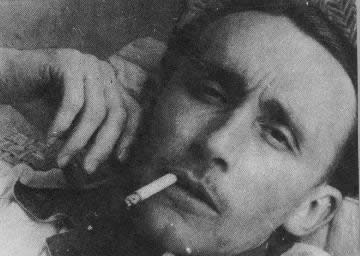
The fourth in a series of essays in honor of André Bazin . . .
André
Bazin was exhilarated by the idea of a cinema grounded in photographic
images that conjured up an intense illusion of space. He saw this
as the center of cinema's power. Montage, he believed, created
only secondary and less powerful effects, merely intellectual and
therefore not as profound. Cutting between shots of a single
location could create a mental impression of the space of the location
but not a visceral sense of experiencing that space first-hand.
“Metaphorical montage”, cutting between images to create a conceptual
relationship between them — as between a shot of a kiss and a shot of
fireworks going off — he saw as equally “intellectual” and thus
equally secondary. Cutting, he believed, tended to undermine the
power of cinema to imaginatively, as opposed to rationally, engage us.
He was on to a signal truth here, but there are some problems with his
argument. He consistently identified cinema's spatial illusion
with realism, and saw that realism, the shared ontological identity of
an actual space and its photographic record, as crucial to cinema's
power. However, as I've argued before, this fails to account for
the cinematic power of hand-drawn or computer-generated images, both of
which can create impressions of spaces which can engage us
imaginatively just as powerfully as photographic images.
Consider also the realm of dreams. We often in dreams enter
spaces which have no correlative in the waking world — a new wing of
our house, for example, which seems just as real as the house we know
in waking life. The impression of “reality” here does not depend
on any shared ontological identity between the imaginary wing and our
dream experience of it. The mechanical authority of the camera
does not figure into the equation, and yet the imaginary wing feels
just as real as the spaces of waking reality. Our dreaming mind
convinces us of this reality without any forensic corroboration.
It is the impression of space alone which links photographed cinema
with animated cinema. Photography and animation are merely
techniques for creating illusions of space which we can imaginatively
enter as wholly and as confidently as we enter the spaces of dreams.
Bazin argues that shots need to convey a sufficient impression of
“realism” to counteract the enervating tendency of montage, which
again is a profound insight, but fails to account fully for the dual
nature of some “metaphorical” editing. When Hitchcock cuts from a
shot of Cary Grant and Eve Marie Saint embracing on the train at the
end of North By Northwest to
a shot of the train entering a tunnel, the intellectual aspect of the
visual pun is clear enough — but both shots are interesting and
powerful plastically, both deliver a visceral impact, so that we can
not only comprehend the meaning of the shot of the train rationally
(as a pun) but also feel it as a physical evocation of intercourse.
Finally, Bazin's evaluation of montage does not fully take into account
the musical effects which editing can create. I would agree with
Bazin that such effects only have true power when the images involved
have an intrinsic plastic power of their own. We have all seen
those “experimental films” in which indifferent images are cut to the
rhythms of a piece of music — their effect is thin, superficial, the
correspondences between the rhythms of the music and the rhythms of the
editing merely mechanical, an exercise in redundancy.
But consider the musical rhythms of the editing in Orson Welles' Falstaff.
The images, however fleeting, are always powerful plastically,
viscerally evoking space, but the editing gives them a new musical
quality — much the way the rhythms of poetic meter confer a
meta-meaning above and beyond the literal meaning of the poet's words.
My arguments with Bazin here are narrow but important, I believe.
If I were speaking with him today, face to face, as I sometimes feel I
actually am, so vivid is his presence in his writing, I would urge him
to cut loose from his attachment to photographic “realism” and
concentrate on the imaginative uses of all illusory space in cinema,
however it's achieved, and to think again about the ways illusory space
can be enlisted in the service of montage, not just as a kind of
compensation for the intellectual reductionism of montage but as a way
of investing montage with an über-cinematic artistic capacity all its
own.
